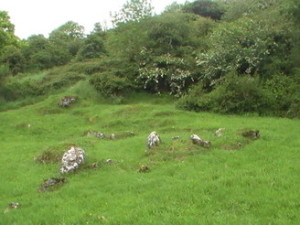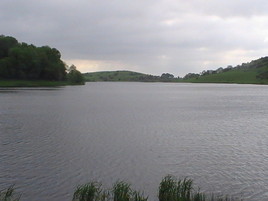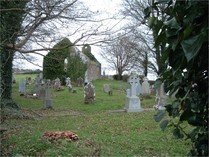Lough Gur is one of Ireland’s archaeological and historical gems. The beautiful and enchanted lake lies 21 km south east of Limerick city.
From the level surrounding countryside it unfolds in beauty its placid waters and rugged hills – a fairyland of stone circles, ancient habitation sites, megalith tombs, crannogs and castles.
Lough Gur tells the story of the pre-Celtic settlers who first came to the area over 6,000 years and continues to the present day in the people who still dwell and farm in the locality. It is an archaeological site of outstanding significance. A visitor centre was built in 1980 and uses the design of two of the excavated stone age houses as its plan. The Centre houses a number of displays covering stone age and bronze age implements, pottery and weaving. A slide show gives a good overview.
The lake is now crescent shaped but this is mainly due to drainage works carried on in the middle of the 19th century. The drainage works reduced the level of the water by about 3 metres and on the newly exposed lakeshore was found the many artefacts which directed archaeological interest to the area.
Lough Gur is one of Ireland’s archaeological and historical gems. The beautiful and enchanted lake lies 21 km south east of Limerick city.
From the level surrounding countryside it unfolds in beauty its placid waters and rugged hills – a fairyland of stone circles, ancient habitation sites, megalithic tombs, crannogs and castles.
The local community now manage the Heritage Centre and can arrange tours of the area for you with an experienced local guide – please contact 087 2852022 or 061 385386 for further information.
Archaeology & History
 Lough Gur has been a place of continuous habitation for at least 6,000 years since the arrival of the Neolithic people and represents in microcosm each of the different ages.
Lough Gur has been a place of continuous habitation for at least 6,000 years since the arrival of the Neolithic people and represents in microcosm each of the different ages.
Examples of archaeological sites for each age include:
Stone Age
- Neolithic houses of Knockadoon
- Megalithic tomb Bronze Age
- Grange Stone Circle
- Enclosed habitation sites on Knockadoon
- Circles O and P
Iron Age
- Ring barrow on Knockfennel
- Hill forts on surrounding hills
Early Christian Period
- Stone forts of Carraig Aille
- The Spectacles
- Bolin island (crannog)
Medieval Period
- Bouchiers Castle
- Black Castle
Post-medieval Period
- New Church (Teampall Nua)
- Mass Rock
- Lime Kiln
- St. Patrick’s Well
Folklore at Lough Gur
 The great folk tale deals with Gearoid Iarla, 3rd Earl of Desmond who was Chief Justice for Ireland in 1367 following the Statutes of Kilkenny. He lived from 1338 to 1398 and as well as dabbling in magic, he composed verse in both Irish and French. As a punishment for his involvement in magic, he did not die but lives beneath the waters of the lake. Every seven years he rides around the lake margin on his white horse, shod with silver shoes. When the shoes are finally worn, he will regain his mortal form and restore the glory of the Desmonds.
The great folk tale deals with Gearoid Iarla, 3rd Earl of Desmond who was Chief Justice for Ireland in 1367 following the Statutes of Kilkenny. He lived from 1338 to 1398 and as well as dabbling in magic, he composed verse in both Irish and French. As a punishment for his involvement in magic, he did not die but lives beneath the waters of the lake. Every seven years he rides around the lake margin on his white horse, shod with silver shoes. When the shoes are finally worn, he will regain his mortal form and restore the glory of the Desmonds.
Owen Bresnan (1847 – 1912) in his manuscript “Lough Gur – its pillarstones, Stone Circles and traditions” recounts the following tale.
“The Covetous Herdsboy – many a tale of Lough Gur have I heard from young and old but none so valuable and interesting as that of the Bean’Ti and her golden comb. Long ago the Bean’Ti sat on her seat, having come up from the depths of the lake. She sat upon her seat and combed her hair with her golden comb which she placed beside her when the work was done. And then the Bean’Ti slept. High above the seat was the hill on which stood the Buachall or a Herdsboy, watched he the lady of the lake as she dressed her golden tresses, saw he the golden comb and coveted it for himself. Bean’Ti sleeping, dreamed not of robber Buachall, who now softly approached the seat and stole the golden comb. From that day, misfortunes hard and fast came upon the buachall and death soon came to him. When he was about to die, he ordered that the golden comb be flung into the lake and so the Bean’Ti joyfully regained it.”

Teampall Nua
Of Owen’s poems the most popular is “Teampall Nua” in which he pays tribute to Thomas O’Connellan, poet-harper who died during a feast at Bouchiers Castle c. 1700 and is buried…
”in that churchyard by Lough Gur’s romantic shore,
where the shamrocks and the ivy every grow
where the wild dove and the raven like protecting spirits soar
o’er the green graves of silent Teampall Nua”

